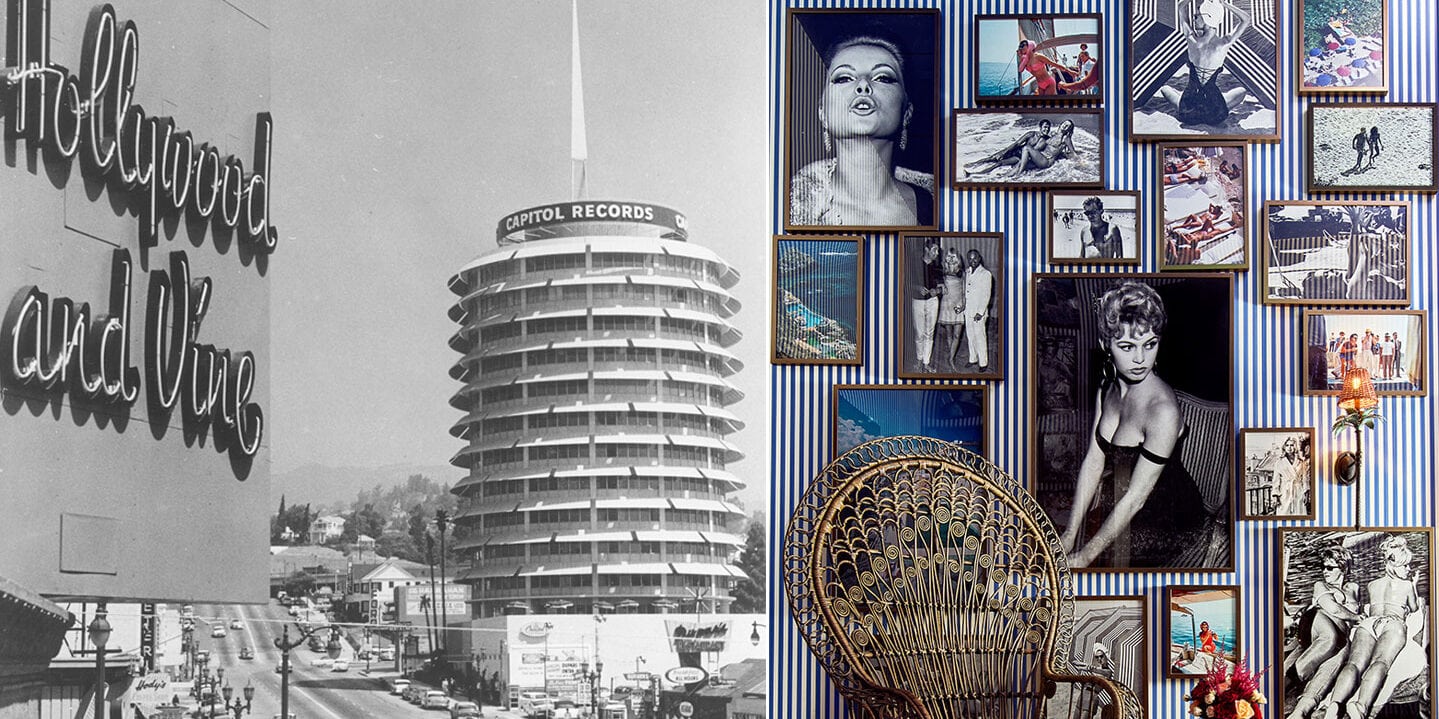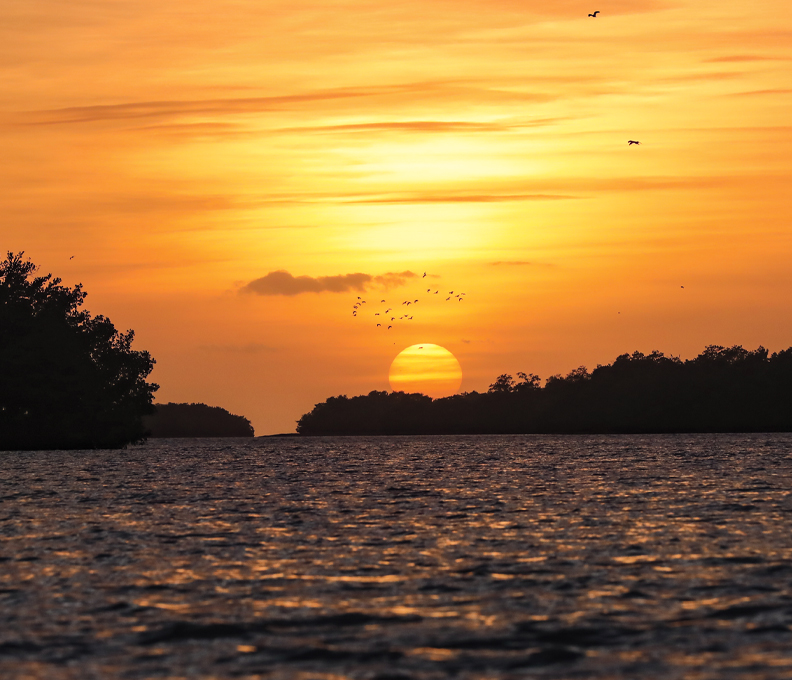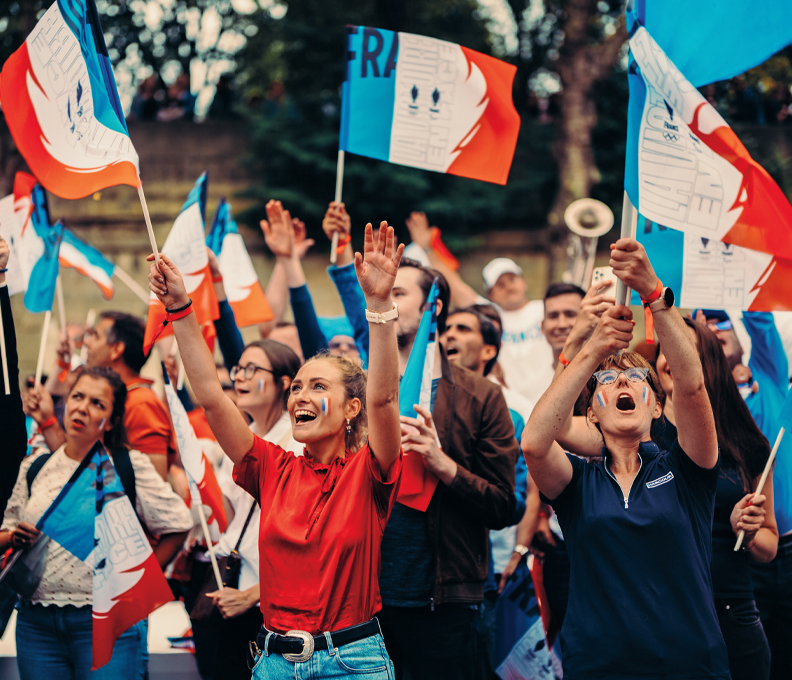The Vinyl Revival: Why People Are Flocking to One of Hollywood’s Most Historic Districts Once Again
June 11, 2022

The renovation of L.A.’s legendary recording district is bringing top talent, vibrant venues, and big dollars to the heart of Hollywood
The Hollywoodian is a majestic beast. We don’t grow up like everyone else. In fact, we grow up like no one else. The sidewalks of our neighborhood are paved in stars, after all. Pink Corvettes cruise the boulevard driven by the same bombshells seen on the billboards lining the boulevard. And if you live up in those steep hills, you might not learn to ride a bike. This kid didn’t.
The heartbeat of Hollywood—Hollywood and Sunset boulevards, bordered roughly by Vine Street and Highland Avenue—rose to fame as the epicenter of 20th-century entertainment, from movies to radio to television to records. As a kid, I remember it as the place Mom told us not to go after dark. Later, as a teenager, it was the place we definitely wanted to go after dark, sneaking into clubs to party alongside the A-list. It’s where I fell in love for the first time and where my heart was broken for the first time, and that L.A. sound, from Dr. Dre and the Red Hot Chili Peppers to No Doubt and Foo Fighters, was the soundtrack to it all.
This is where legendary artists and recording studios gave birth to some of the greatest songs and albums of the last 100 years. Now, as Hollywood rises once again, its Vinyl District—concentrated west of Vine Street through Ivar Avenue, Cahuenga Boulevard, Wilcox Avenue and Schrader Boulevard—is a hub of chic restaurants and hotels, vintage record stores and rooftop parties, backed by visionaries who are invested in its success. It’s the perfect trifecta of past and present coming together to define the future.

The Highlight Room at the Dream hotel / Photo: Courtesy of Dream Hollywood
Nowadays
“When you look at how these movie theaters, record companies and radio and TV stations really concentrated along this area, you see how important the media was to the development of Hollywood,” says architectural historian Alan Hess. He notes that this pocket district features two of the city’s top design landmarks, the Capitol Records Building and the geodesic Cinerama Dome, both designed by modernist Welton Becket, who also is credited with downtown’s Music Center.
The circular Capitol Records Building is sacred ground for American music, with its famed recording studios hosting everyone from Nat King Cole to the Beastie Boys.
In 2014, Relevant Group, headed by Grant King, began to assemble real estate in the underdeveloped central Hollywood neighborhood with a plan to create a thriving cultural hub. Land here was still affordable by Los Angeles standards. What it didn’t already have in lifestyle nuance it more than made up for in history.
“We saw this as an opportunity to bring a different perspective to this neighborhood, and over the course of four years, we assembled a campus,” says Dan Daley, COO of Relevant Group and principal of Ten Five Hospitality. Ten Five’s Thompson, Tommie and Dream hotels, restaurants Mother Wolf, Ka’teen and Mes Amis and nightlife venues Bar Lis and Desert Five Spot all occupy Relevant Group real estate. “This area is surrounded by so many different parts of Los Angeles, from the Hills to Hancock Park, and you’re in relative proximity to West Hollywood. Netflix and production companies are moving into the market, to say nothing of the existing studios that have been around. So it just was just ripe from virtually every angle.”
As the projects began to take shape, King came up with the name Vinyl District, reflecting the heritage of the streets just outside of Hollywood’s main tourist area but worlds away from the sight-seeing buses and buskers. “It was fitting to create a district that encapsulated that vibrant music industry—fine dining, phenomenal nightlife, excellent hotels, high-end retail,” says Vaughn Davis, general manager of the Dream hotel, the first Relevant project to open in the neighborhood in 2017. “Hollywood is in the midst of a renaissance.”
Davis likens it to L.A.’s version of New York City’s Meatpacking District. The Dream features hospitality giant Tao Group’s entry into the West Coast, with versions of their popular Beauty & Essex and Tao restaurant, as well as The Highlight Room, a rooftop pool deck and nightclub specifically developed for Los Angeles.
Pavan Pardasani, CMO of Tao Group, spent six years watching this corner of the world rebuild from the ground up, day in and day out. “This used to be a dark, quiet street. Tao was a one-story auto-body shop. The Dream hotel was a parking garage. We created a beacon of light on this block when we opened it.”
Quite literally a spotlight, as it’s now a thriving center of fun with cars lined up outside, socialites taking selfies in the verdant entryway, and celebrities and notables toasting to the good life while taking in panoramic views of the hills. Since the Dream’s debut, the Relevant Group portfolio now includes more than $1 billion worth of development projects throughout Los Angeles.
“With the Thompson opening [down the street from the Dream in 2021], they have some great food and beverage concepts,” Pardasani says. “Evan Funke’s Mother Wolf is doing quite well in the Citizen News building [between the Thompson and Tommie]. And Grandmaster Recorders is super cool, right down the block on Cahuenga.”
“The full realization of the vision is happening,” Daley says. “On a Saturday night in April we had 2,500 non-hotel guests circulating the properties, enjoying food and beverage and the neighborhood.”

Dining room at MotherWolf
They visited Evan Funke’s acclaimed Roman restaurant Mother Wolf, designed by Martin Brudnizki. They went to the rooftop Desert Five Spot, a country and western bar. They went to Bar Lis, which evokes the 1950s and ’60s glam of the Côte d’Azur. “We set out to create radically different experiences and designs, all in close proximity to one another. It is fun to go from one venue to the next and receive such a different sensory experience.”
The campus got a big boost of credibility with the arrival of Wes Avila, the James Beard-nominated chef from Pico Rivera, California, known for his Guerrilla Tacos and Angry Egret Dinette. He commands the kitchen at the lush, open-air Ka’teen restaurant adjacent to the Tommie hotel.
“L.A. locals have a different take on Hollywood—we don’t go there,” he says with a laugh. “It is mostly tourist traps, with the exception of Musso & Frank [the oldest restaurant in Hollywood and a landmark]. But when I heard about the idea to build out this campus, which included Lincoln Carson’s Mes Amis and Evan Funke’s Mother Wolf, all in the heart of Hollywood, and create something unique to Los Angeles—but also have the freedom to add my twist—I was all-in.”
The food he defined for Ka’teen is Alta California (the opposite of Baja): laid-back, Mexican at heart, but with influences from everywhere. Think tortillas dabbed in French butter, whole wood-fired fish, and tequila cocktails smudged with sage. “When it comes to food in L.A., it’s still the Wild West,” Avila says. “You can come here and reinvent yourself and knock it out of the park, and you don’t need that backstory. The key to longevity is if you’re good, you’ll stay open.”

Mama Shelter rooftop / Photo: Courtesy of Mama Shelter
Back in the days
Beyond all the development, though, the neighborhood still has range. Across from Dream and down the street from hipster Euro hotel Mama Shelter is one of the most popular rare vinyl stores in the world, The Record Parlour.
For more than a decade, Chadwick Hemus would walk the streets between Hollywood and Sunset boulevards while on breaks from his job running the vinyl department at Amoeba Music’s flagship store. In the early 2000s this neighborhood was run-down, shades away from its former glory as the epicenter of recording studios and film houses.
“It was rough,” Hemus says. “There still wasn’t anything going on. It was very different terrain, pretty much the same it had been for many decades.”

Record Parlour owners Chadwick Hemus and Chris Honetschlager / Photo: Courtesy of The Record Store Book/Photos by Mike Spitz
In between the parking lots and auto-body shops, Hemus discovered a building around 100 years old. “It was a print shop back in the early Hollywood days—lower-end studios and then a lot of peripheral businesses. At some point it became a modeling agency for a while, and then a design company called Spacecraft. I used to walk by all the time and think, This should be used for something cool.” In 2013, Hemus and business partner Chris Honetschlaeger opened The Record Parlour in the space. The two audiophiles came together through a mutual love of records, vintage audio devices, coin-op machines and jukeboxes. Now The Record Parlour is expanding to include a new lounge, bar and event space with coin-op games.
“This area has the most recording studios in the world,” he says. “I like that we are paying homage to that, because there’s a lot of depth from the big labels like Capitol to Marvin Gaye’s studio, small punk labels like Mystic Records, and Cherokee Studios [which Beatles producer George Martin called the best in America].”
Marvin’s Room, immortalized by Drake in the 2011 song of the same name, opened in 1975 on Sunset Boulevard. It is where the singer recorded the hit “Got to Give It Up” and threw legendary parties with guests such as Diana Ross and Muhammad Ali. By the mid 1980s it had a new life as Eldorado Studios, attracting Prince, Michael Jackson, Mary J. Blige, Usher and many more.
Over on Cahuenga, the Grandmaster Recorders studio, which operated from 1971 to 2016, has been reborn as a restaurant, rooftop and lounge. The project is the creation of Australian DJ-turned-restaurateur Grant Smillie, co-founder and principal of Botanical Hospitality. The group’s E.P. & L.P. Restaurant & Rooftop has been a West Hollywood hotspot for years, counting Swedish House Mafia DJ Axwell as a partner.
When Smillie heard about a vacant property in Hollywood that had been a recording studio, it immediately piqued his interest. The narrative of the space came ready-made. “I just had to do it,” he says. “Grandmaster had a legacy of legendary albums recorded here. I wondered how we could wrap hospitality around what was a studio and still be cool. “This was Dave Grohl’s favorite drum recording room of all time,” he continues. “Every Foo Fighters drum track was recorded primarily at Grandmaster. I kept the original red door that went between the studios, and that’s in our office. There’s a great old red tub that apparently Deborah Harry used to swim around. I’m thinking about bringing it back for an event. There was even graffiti found around the place that’s not on display at the moment. But we have the mezzanine area where artists left their mark on the wall.”
Grandmaster’s food program is headed up by culinary director Monty Koludrovic and his partner, Jaci, both from Australia. The historic building where some of the greatest albums of the 20th century were recorded features a New World Italian restaurant with inventive dishes such as mortadella churros and caviar cannoli.
“I saw the potential to engage in an impressive building, and I grew up loving music,” says Koludrovic. “But I didn’t want there to be a literal relationship between the building, the history and the food. I wanted those things to stand on their own. I love that people can come and engage with the building, and then engage in food. The finer things paired with old, historical, raw elements. You can have a half pound of caviar in a space where your chairs are not quite stable, because they used to make guitar pedals where you’re sitting.”

MainRo super club / Photo: Wonho Photo
The Next Days
On the corner of Ivar Avenue and Hollywood Boulevard, Miami nightlife mogul Romain Zago recently unveiled MainRo, a high-energy supper club with food, cocktails and theater under one roof. Called the most technologically advanced restaurant in the city, MainRo uses digital art to immerse guests in the environment. Sixteen triangular chandeliers outfitted in ultra-4K screens move independently throughout the evening. Electronic tables transition from dining to nightlife mode with the flip of a switch. Walls with reflective paneling create mind-bending lighting and visuals, while an ornate staircase features ultra-4K screens on every step.
Outside, Hollywood Boulevard is also taking shape. Vaughn says to expect a lot of new venues around the historic corridor.
“This is the Heart of Hollywood initiative, a rebranding and renovation of the boulevard,” he says. “Hollywood is the most iconic brand in the world. Everyone knows it because of its association with movies. It’s important for us to ensure that Hollywood the place is an accurate reflection of the brand. We are developing with intelligent design and intent, preserving the history but beautifying it. When you get off the plane and take an Uber into Hollywood, in the next two or three years, it’s going to feel like what you saw on television.”



